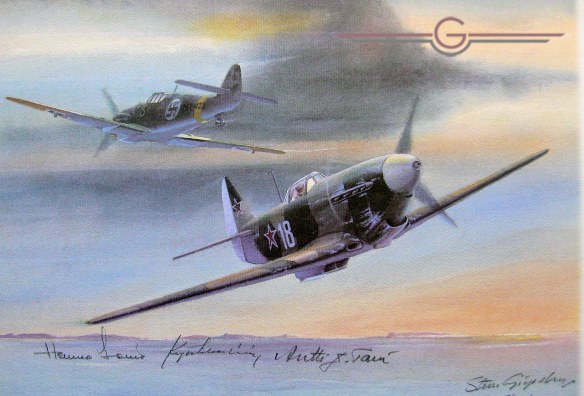Yak-9. Stalin’s Hawk
In the continuation war between Finland and the USSR the most common fighters were the Yak series 1-7 and 9, and the Messerschmitt 109 G2 and G6 used by the Finnish Air Force. The planes had structural differences, but generally taken performance was nearly identical. Speed at low level 620640 km/h, but at 6000m and above the bf 109 was faster at approx, 680 km/h. Good visibility was an important feature of the Yaks. The cockpit offered a 360° view, and a head shield of plexiglass as a novelty. Good maneuverability and performance were characteristics of the Yak-series. The Yak-series were products of the Alexander Yakovlev design bureau. Some 37 000 aircraft were produced 1941-1945, of these over 16 000 were Yak-9s.
The prints are signed by veteran pilots H. Leino and K. Karhila.
Joseph Stalin had a longstanding personal interest in aviation, which led to large investment of prewar funds in the Red Army Air Force (VVS). Soviet fighters were therefore plentiful at the start of the German–Soviet war in June 1941, but also mostly obsolete. Thousands of “Stalin’s Hawks” were easily destroyed on the ground in the first days of BARBAROSSA, and thousands more were blown from the sky or abandoned in panicked retreats and routs. Over 22,000 aircraft (all types) were lost to the VVS in the first six months of war. Soviet fighters were especially inadequate in 1941 because a small number of technically outmoded or design deficient models had been mass produced prewar. Failure also reflected a dearth of aircraft research and design personnel in Soviet industry in the late 1930s, due mainly to the terrible military purges that hit the VVS particularly hard during the Yezhovshchina . The most common VVS fighter type was a small monoplane, the Polikarpov I-16 “Rata.” Known derisively as “donkeys” among krasnoarmeets, nearly 10,000 were built in the second half of the 1930s. The Rata could not climb with, stay with, or outgun a Bf109. Despondent Red Army soldiers watched thousands of I-16s smoke into the forest or steppe, and abandoned others on the ground as useless. The 1939 model I-153 fighter was also a slow biplane, of which nearly 3,500 had entered VVS service by 1941.
A crucial difference between the VVS and the Luftwaffe was that Soviet fighters improved far more during the war than did German planes opposing them. Designers were released from the GULAG after June 1941. New designs were swiftly laid down and completion of old ones greatly speeded into production. New models came on stream during 1942, produced in large numbers mainly in factories relocated to the Urals. In marked contrast, the Luftwaffe mostly made incremental improvements to established fighter models. That decision mainly resulted from pressing need caused by remarkable aircraft attrition at the front, and later over Germany. But the Luftwaffe also wasted design talent on far too many experimental types and on premature production of immature jet technology. VVS fighter pilots thus soon appeared over the battlefield in superior aircraft such as the LaGG-3, which had a top speed of 342 mph, a range of 345 miles, and a ceiling of 31,000 feet. The Yak-1 achieved a maximum speed of 360 mph, a range of 434 miles, and a fighting ceiling of 33,000 feet. The Yak-3 reached a 35,000 foot ceiling and could fly at level combat speeds over 400 mph. The Yak-9D, of which over 14,600 were built, had a lower top speed at just 375 mph, but its range of nearly 900 miles allowed VVS fighters to escort late war Soviet medium and heavy strategic bombers. The MiG-3, one in a long line of Soviet fighters named for their top-drawer designers, (Mi)koyan and (G)urevich, attained level combat speeds of 400 mph, had a range of over 600 miles, and reached a ceiling of nearly 40,000 feet. The “Lavotchkin” or La-5 was an outstanding modern fighter with flying ratings of 405 mph, 475 miles, and 31,000 feet. About 9,900 La-5s were built, plus another 5,800 La-7s, a sleek fighter capable of 425 mph and 32,500 feet, but with a limited range under 400 miles.
